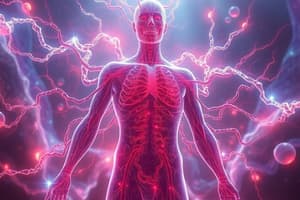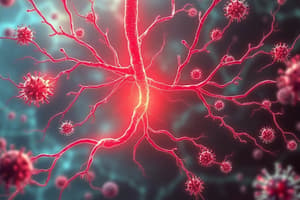Podcast
Questions and Answers
What is the procedure called for the removal of infected palatine tonsils?
What is the procedure called for the removal of infected palatine tonsils?
- Adenoidectomy
- Lymphadenectomy
- Spleenectomy
- Tonsillectomy (correct)
Which of the following lymphatic structures is most commonly associated with the groin area?
Which of the following lymphatic structures is most commonly associated with the groin area?
- Thoracic nodes
- Cervical nodes
- Inguinal nodes (correct)
- Axillary nodes
What type of pulp in the spleen surrounds the arteries and is involved in lymphatic functions?
What type of pulp in the spleen surrounds the arteries and is involved in lymphatic functions?
- Cortical pulp
- Red pulp
- Connective pulp
- White pulp (correct)
Which area contains rapidly dividing lymphocytes within lymphatic nodules?
Which area contains rapidly dividing lymphocytes within lymphatic nodules?
What is the role of macrophages found in lymphatic sinuses?
What is the role of macrophages found in lymphatic sinuses?
Where is the thymus gland located in the body?
Where is the thymus gland located in the body?
What distinguishes lymphatic nodules from lymph nodes?
What distinguishes lymphatic nodules from lymph nodes?
What is the primary function of the spleen?
What is the primary function of the spleen?
What is the primary function of the lymphatic system in terms of fluid management?
What is the primary function of the lymphatic system in terms of fluid management?
Which lymphatic vessel receives lymph from the right upper limb, head, neck, and chest?
Which lymphatic vessel receives lymph from the right upper limb, head, neck, and chest?
Which of the following functions is NOT performed by lymphatic vessels?
Which of the following functions is NOT performed by lymphatic vessels?
What are the white-appearing lymphatic fluids that pass through lacteals called?
What are the white-appearing lymphatic fluids that pass through lacteals called?
Which type of lymphatic organ is primarily involved in filtering bacteria from oral and nasal cavities?
Which type of lymphatic organ is primarily involved in filtering bacteria from oral and nasal cavities?
Which of the following statements about lymphatic capillaries is incorrect?
Which of the following statements about lymphatic capillaries is incorrect?
Which of the following lymphatic organs can be found in the back of the mouth?
Which of the following lymphatic organs can be found in the back of the mouth?
What role does the contraction of skeletal muscles play in the lymphatic system?
What role does the contraction of skeletal muscles play in the lymphatic system?
What is the primary role of the medulla in lymphoid organs?
What is the primary role of the medulla in lymphoid organs?
Which of the following best describes innate immunity?
Which of the following best describes innate immunity?
What initiates the movement of white blood cells toward infection sites?
What initiates the movement of white blood cells toward infection sites?
Which of the following cells are primarily responsible for the first response to infection?
Which of the following cells are primarily responsible for the first response to infection?
What characterizes local inflammation?
What characterizes local inflammation?
Which cells are classified within the mononuclear phagocytic system?
Which cells are classified within the mononuclear phagocytic system?
What is the role of natural killer cells in the immune response?
What is the role of natural killer cells in the immune response?
What is a common result of the accumulation of neutrophils at an infection site?
What is a common result of the accumulation of neutrophils at an infection site?
What is the primary role of pyrogens in the body?
What is the primary role of pyrogens in the body?
Which characteristic of adaptive immunity allows it to respond more effectively to repeated exposures to the same antigen?
Which characteristic of adaptive immunity allows it to respond more effectively to repeated exposures to the same antigen?
What kind of immune response is triggered by foreign antigens?
What kind of immune response is triggered by foreign antigens?
Which cells are primarily responsible for producing antibodies in the adaptive immune response?
Which cells are primarily responsible for producing antibodies in the adaptive immune response?
What is the role of cytokines in lymphocyte activation?
What is the role of cytokines in lymphocyte activation?
What are major histocompatibility complex (MHC) molecules primarily responsible for?
What are major histocompatibility complex (MHC) molecules primarily responsible for?
Which cytokine is released by macrophages to stimulate helper T cells?
Which cytokine is released by macrophages to stimulate helper T cells?
What happens during B-cell proliferation?
What happens during B-cell proliferation?
What is the role of plasma cells in antibody-mediated immunity?
What is the role of plasma cells in antibody-mediated immunity?
Which part of the antibody directly interacts with the antigen?
Which part of the antibody directly interacts with the antigen?
What characterizes passive immunity?
What characterizes passive immunity?
How does the constant region of an antibody function after it binds to an antigen?
How does the constant region of an antibody function after it binds to an antigen?
What defines secondary response in antibody-mediated immunity?
What defines secondary response in antibody-mediated immunity?
Which of the following describes active natural immunity?
Which of the following describes active natural immunity?
Which cells are primarily involved in cell-mediated immunity?
Which cells are primarily involved in cell-mediated immunity?
What is the main difference between natural and artificial immunity?
What is the main difference between natural and artificial immunity?
Flashcards
Lymph
Lymph
Fluid that circulates in the lymphatic system, originating from interstitial fluid and eventually draining into the circulatory system.
Lipid Absorption (Lymphatic system)
Lipid Absorption (Lymphatic system)
The process of absorbing fats from the small intestine into the lymphatic system.
Lymphatic Capillaries
Lymphatic Capillaries
Tiny, closed-ended vessels that collect fluid from tissues and form the beginning of the lymphatic system.
Lymphatic Vessels
Lymphatic Vessels
Signup and view all the flashcards
Right Lymphatic Duct
Right Lymphatic Duct
Signup and view all the flashcards
Thoracic Duct
Thoracic Duct
Signup and view all the flashcards
Lymph Nodes
Lymph Nodes
Signup and view all the flashcards
Tonsils
Tonsils
Signup and view all the flashcards
Tonsillitis
Tonsillitis
Signup and view all the flashcards
Tonsillectomy
Tonsillectomy
Signup and view all the flashcards
Adenoidectomy
Adenoidectomy
Signup and view all the flashcards
Lymph Node Cortex
Lymph Node Cortex
Signup and view all the flashcards
Lymphatic Nodules
Lymphatic Nodules
Signup and view all the flashcards
Lymphatic Sinuses
Lymphatic Sinuses
Signup and view all the flashcards
Spleen
Spleen
Signup and view all the flashcards
Immunity
Immunity
Signup and view all the flashcards
Innate Immunity
Innate Immunity
Signup and view all the flashcards
Complement
Complement
Signup and view all the flashcards
Interferons
Interferons
Signup and view all the flashcards
Chemotaxis
Chemotaxis
Signup and view all the flashcards
Phagocytosis
Phagocytosis
Signup and view all the flashcards
Macrophages
Macrophages
Signup and view all the flashcards
Natural Killer Cells
Natural Killer Cells
Signup and view all the flashcards
Specificity in Adaptive Immunity
Specificity in Adaptive Immunity
Signup and view all the flashcards
Memory in Adaptive Immunity
Memory in Adaptive Immunity
Signup and view all the flashcards
Antigens
Antigens
Signup and view all the flashcards
Foreign Antigens
Foreign Antigens
Signup and view all the flashcards
Self-Antigens
Self-Antigens
Signup and view all the flashcards
Antibody-Mediated Immunity
Antibody-Mediated Immunity
Signup and view all the flashcards
Cell-Mediated Immunity
Cell-Mediated Immunity
Signup and view all the flashcards
Stem Cells
Stem Cells
Signup and view all the flashcards
What are antibodies?
What are antibodies?
Signup and view all the flashcards
What is the variable region of an antibody?
What is the variable region of an antibody?
Signup and view all the flashcards
What is the constant region of an antibody?
What is the constant region of an antibody?
Signup and view all the flashcards
What are plasma cells?
What are plasma cells?
Signup and view all the flashcards
What are memory B cells?
What are memory B cells?
Signup and view all the flashcards
What is active immunity?
What is active immunity?
Signup and view all the flashcards
What is passive immunity?
What is passive immunity?
Signup and view all the flashcards
What is cell-mediated immunity?
What is cell-mediated immunity?
Signup and view all the flashcards
Study Notes
Lymphatic System and Immunity
- Pathogens: Microorganisms that cause diseases or damage to tissues.
- Lymphatic System Functions:
- Fluid Balance: Maintains fluid balance by collecting lymph (fluid that enters lymphatic capillaries)
- Lipid Absorption: Absorbs lipids (fats) through lacteals (lymphatic vessels in the small intestine), where lymph appears white and is called chyle.
- Defense: Protects the body from disease.
- Lymphatic System Anatomy:
- Lymphatic Capillaries: Tiny, closed-ended vessels found in most tissues (except CNS, bone marrow, and epidermis). Consist of simple squamous epithelium.
- Lymphatic Vessels: Resemble small veins, have one-way valves similar to veins. Two main ducts: Right Lymphatic Duct (drains right upper limb, right half of head, neck, and chest), and Thoracic Duct (rest of the body).
- Lymphatic Vessel Contraction: 3 factors cause contraction—skeletal muscle activity, periodic contractions of lymphatic vessels' smooth muscle, and pressure changes in the thorax (during breathing).
- Lymphatic Organs: Tonsils, Lymph nodes, Spleen, and Thymus.
- Lymphatic Tissues: Lymph nodes contain lymphocytes (originating from red bone marrow) and macrophages.
- Tonsils: Located in the back of the mouth and top of the throat. Help filter out bacteria and germs to prevent infection. 3 types: Palatine, Pharyngeal, and Lingual Tonsils.
- Lymph Nodes: Small, bean-shaped structures along lymphatic vessels. Contain lymphocytes and macrophages to fight infection. Typically grouped in areas of the body like the groin (inguinal), armpit (axillary), and neck (cervical). Lymph nodes are surrounded by a capsule with trabeculae that divide the node into compartments. (Consist of lymphatic tissue and sinuses.)
- Spleen: Organ roughly the size of a clenched fist, in the upper left abdominal cavity. It filters blood, has an outer capsule of dense connective tissue and smooth muscle. Consists of white pulp (lymphatic tissue around arteries) and red pulp (lymphatic tissue associated with veins). Filters blood instead of lymph.
- Thymus: Bilobed gland in the superior mediastinum. Site of maturation for a class of lymphocytes called T cells.
- Immunology: Body's ability to resist damage.
- Innate Immunity: Nonspecific defense, recognizes and destroys foreign substances the same way every time.
- Physical Barriers: Prevent microorganism entry—skin and mucous membranes.
- Immune Mediators: Chemicals in innate immunity (examples: complements, interferons).
- White Blood Cells: Important cellular components of immunity. Chemicals known to attract white blood cells: complement, leukotrienes, kinins, histamine.
- Phagocytic Cells: Ingest and destroy particles—examples: neutrophils, macrophages (part of mononuclear phagocytic system).
- Inflammation: Body's local response to injury or infection (symptoms: redness, heat, swelling, pain). Systemic response also involves an increase in neutrophils, fever, and shock. Pyrogens stimulate fever production.
- Adaptive Immunity: Specialized response in fighting pathogens. 2 main characteristics—specificity and memory.
- Specificity: Ability to recognize and respond to specific substances.
- Memory: Responds with increasing effectiveness to subsequent exposure.
- Antigens: Substances that stimulate adaptive immune responses. Foreign and self-antigens are possible.
- Antibody-mediated immunity: Antibody production.
- Cell-mediated immunity: T-cell activity (examples: cytotoxic T cells, helper T cells).
- Natural and Artificial Immunity: Ways adaptive immunity is achieved through exposure (natural exposure) or through deliberate exposure—vaccination (artificial exposure). Natural exposure is not deliberate while artificial is deliberate.
- Passive Immunity: Transferring immunity from an immune individual to a non-immune individual (examples include transfer of maternal antibodies, antiserum—antibodies from another individual).
- Immunotherapy: Treating disease by altering immune system function or attacking harmful cells. Some approaches aim to boost immune system function.
Studying That Suits You
Use AI to generate personalized quizzes and flashcards to suit your learning preferences.





